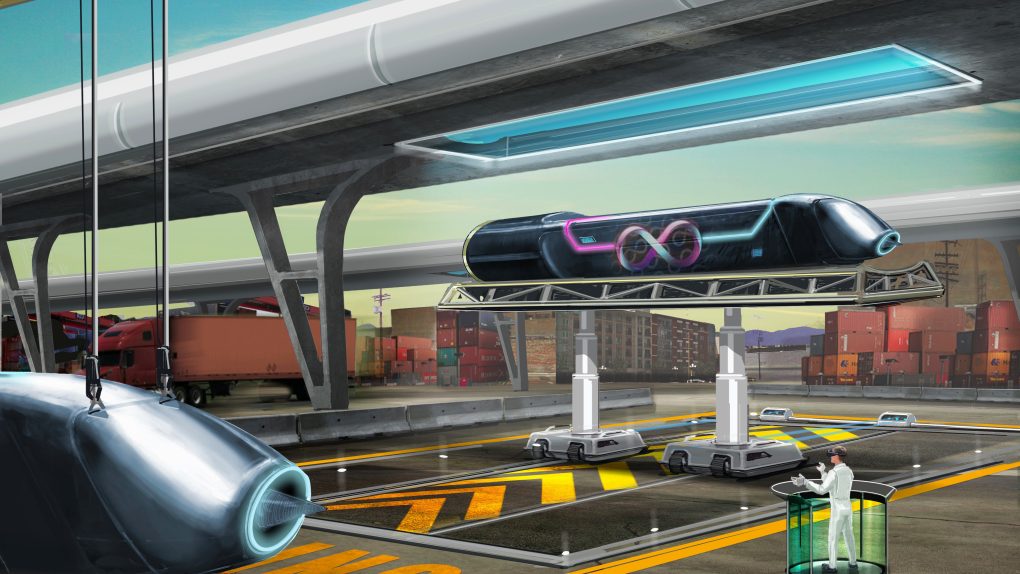Yesterday, Hyperloop One conducted the first test of the propulsion system that may eventually shoot people through tubes at very high speeds. Hyperloop One’s CEO Rob Lloyd described the test as an “engineering milestone,” but while it was undoubtedly impressive, Hyperloop still has a long way to go.
It’s worth remembering how Hyperloop is supposed to work. In Elon Musk’s original plans, a pod carrying humans travels down a tube in a partial vacuum, levitating using compressed air, and being propelled forwards using electromagnets.
Yesterday’s test only involved the propulsion component. A “sled” carrying the linear induction motor shot down an empty track, accelerating from 0 to 120mph in 1.5 seconds, and topping out at 300mph. It was a good spectacle for the assembled press, but in reality, little more than a glorified roller coaster.
The linear induction motor being tested is actually one of the most proven Hyperloop components. Trains first started carrying passengers using the technology in 1984, and it’s in use with roller coasters today. Hyperloop One’s test also just looked at acceleration — the bigger question with Hyperloop down the line is how efficient linear induction will be over hundreds of miles, carrying much heavier loads with years of wear and tear.
Other components like compressed air levitation and the pipelines are solid from a physics perspective, but remain untested for this kind of application, at this kind of scale. Sure, we’ve been building pipelines to carry oil and water for decades, but there’s a big difference between containing a liquid and a vacuum, especially a vacuum that people will be travelling through. A list of oil pipeline accidents in the US alone makes for bleak reading, and Hyperloop One hasn’t made clear how it will suddenly do better than an industry that’s been building pipelines for well over a century.
DON’T MISS: You can watch the first full-scale Hyperloop test right here
The biggest hurdles for Hyperloop aren’t going to be technological, though: it’s more about where they’re going to build their tracks, and who is going to pay. In order for Hyperloop to reach high speeds (and thus be worth the hassle over high-speed rail), the pipes need to be straight. Really straight. And since there will probably be houses and towns between any two points that Hyperloop wants to connect, it’s going to take some serious government willpower to make Hyperloop happen.
Lloyd acknowledged as much in an interview with Engadget:
“I think first and foremost it’s going to take government support to create a regulatory framework to make Hyperloop a possibility…We think we’re generally so much aligned with government policy, we just need to educate governments and get them on our side.”
Saying you “just” need to get governments on your side is kinda like telling Frodo he “just” has to climb up Mount Doom. It’s a classic Silicon Valley startup approach: design the technology, and forget the financial and political capital needed to make it all happen.
All this isn’t to say that Hyperloop won’t be coming — it’s just a gut check on a technology that’s getting hyped out of hand. In the same Engadget interview, Lloyd predicts that freight will be running through Hyperloop tubes by 2019, and passenger pods will be up and running by 2021.
That’s not his timeline for a test track — that’s when he thinks real commercial applications will be up and running. I love the enthusiasm — and let’s be clear, I’ll be the first person riding on a real-life Hyperloop — but it sounds wildly unrealistic. Even if Lloyd can persuade a government to invest tomorrow, and even if he has the full technical specs tested and ready to build, I still think he’s off by orders of magnitude. Construction on the LA to SF high-speed rail link began last year, but passengers aren’t expected to be traveling on the route until 2025.
Hyperloop One’s test yesterday was a big deal — using electromagnets to accelerate a sled down a train track at hundreds of miles an hour is no mean feat. But that’s all it was: a cool roller coaster ride, not a green light on the “fifth great mode of transportation.”










